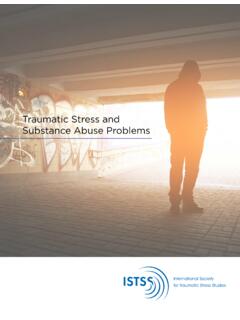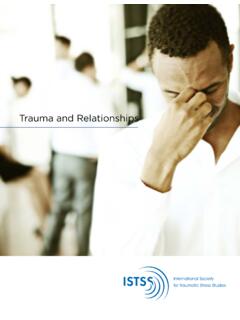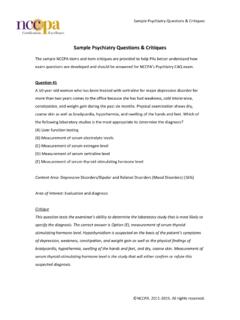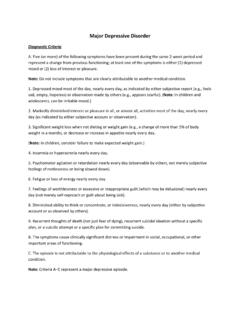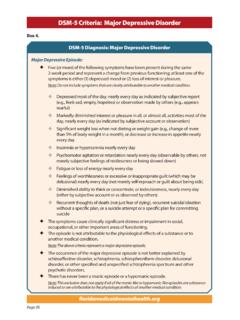Transcription of Trauma and Stress-Related Disorders in DSM-5
1 Trauma and Stress-Related Disorders in DSM-5 Matthew J. Friedman MD, PhD National Center for PTSD Geisel School of Medicine at Dartmouth Disclosures Sources of Research Support 1. Department of Veterans Affairs 2. Department of Defense Paid Editorial Relationship None Consulting Relationship PRN Stock Equity (>$10,000) None Speaker s Bureau None Bottom Line a variety of clinical phenotypes are consistent with PTSD diagnostic criteria, it can no longer simply be considered an Anxiety Disorder is reflected in the new DSM-5 chapter: Trauma and Stressor- related Disorders 3 American Psychiatric Association. (2013) Diagnostic and Statistical Manual of Mental Disorders , (5th ed.). Washington, DC: Author. DSM-5 : Metastructure Neurodevelopmental Disorders Schizophrenia Spectrum & Other Psychotic Disorders Bipolar & related Disorders depressive Disorders Anxiety Disorders Obsessive-Compulsive, Stereotypic & related Disorders Trauma - and Stressor- related Disorders Dissociative Disorders Somatic Symptom Disorders etc.
2 DSM-IV Anxiety Disorders in DSM-5 Anxiety Disorders Panic, Specific Phobia, Social Phobia, GAD etc. O-C, Stereotypic & related Disorders OCD, Body Dysmorphic, Hoarding, Hair Pulling, Skin Picking, etc. Trauma - and Stressor- related Disorders PTSD, ASD, ADs, Reactive Attachment Disorder, etc. Dissociative Disorders DID, Depersonalization/Derealization, Dissociative Amnesia, etc. In the following slides, the DSM-5 criteria and language are paraphrased from the specific wording that appears in the DSM-5 manual. If you wish to see the precise wording, please consult the DSM-5 manual. DSM-5 : Changes to PTSD Criteria Criterion A2 (response involves fear, helplessness, or horror ) removed from DSM-5 3 clusters are divided into 4 clusters in DSM-5 3 new symptoms were added Other symptoms revised to clarify symptom expression All symptoms began or worsened after the Trauma Separate diagnostic criteria for preschool (children 6 years or younger) New dissociative subtype for PTSD added DSM-5 : PTSD Criterion A A.
3 The person was exposed to: death, threatened death, actual or threatened serious injury, or actual or threatened sexual violence, as follows: 1. Direct exposure , in person Criterion A continues on next slide.. DSM-5 : PTSD Criterion A Criterion A (continued): 3. Indirectly, by learning that a close relative or close friend was exposed to Trauma . If the event involved actual or threatened death, it must have been violent or accidental. 4. Repeated or extreme indirect exposure to aversive details of the event(s), usually in the course of professional duties ( , first responders, collecting body parts; professionals repeatedly exposed to details of child abuse). This does not include indirect non-professional exposure through electronic media, television, movies or pictures. PTSD Criteria for DSM-5 symptoms avoidance of stimuli associated with the Trauma alterations in cognitions and mood that are associated with the traumatic event in arousal and reactivity that are associated with the traumatic event DSM-5 : PTSD Criterion B (1/5 symptoms needed) , involuntary and intrusive recollections * * children may express this symptom in repetitive play nightmares * * children may have disturbing dreams without content related to Trauma Criterion B continues on next slide.
4 DSM-5 : PTSD Criterion B Criterion B (continued): reactions ( flashbacks) which may occur on a continuum from brief episodes to complete loss of consciousness * * children may re-enact the event in play 4. Intense or prolonged distress after exposure to traumatic reminders physiological reactivity after exposure to Trauma - related stimuli DSM-5 : PTSD Criterion C C. Persistent effortful avoidance of distressing Trauma - related stimuli after the event (1/2 symptoms needed): 1. Trauma - related thoughts or feelings 2. Trauma - related external reminders ( people, places, conversations, activities, objects or situations) DSM-5 : PTSD Criterion D alterations in cognitions and mood that began or worsened after the traumatic event (2/7 symptoms needed) to recall key features of the traumatic event (usually dissociative amnesia; not due to head injury, alcohol or drugs) (C3 in DSM-IV) Criterion D continues on next slide.
5 DSM-5 : PTSD Criterion D Criterion D (continued): (& often distorted) negative beliefs and expectations about oneself or the world ( I am bad, the world is completely dangerous ) (C7 in DSM-IV) distorted blame of self or others for causing the traumatic event or for resulting consequences (new) Criterion D continues on next slide. DSM-5 : PTSD Criterion D Criterion D (continued): negative Trauma - related emotions ( fear, horror, anger, guilt, or shame) (new) diminished interest in (pre-traumatic) significant activities (C4 in DSM-IV) alienated from others ( detachment or estrangement) (C5 in DSM-IV) affect: persistent inability to experience positive emotions (C6 in DSM-IV) DSM-5 : PTSD Criterion E alterations in arousal and reactivity that began or worsened after the traumatic event (2/6 symptoms needed) or aggressive behavior (revised D2 in DSM-IV) or reckless behavior (new) Criterion E continues on next slide.
6 DSM-5 : PTSD Criterion E Criterion E (continued): (D4 in DSM-IV) startle response (D5 in DSM-IV) in concentration (D3 in DSM-IV) disturbance (D1 in DSM-IV) PTSD Criteria for DSM-5 of symptoms (in Criteria B, C, D and E) for more than one month symptom- related distress or functional impairment H. Not due to medication, substance or illness Preschool Subtype: 6 Years or Younger Relative to broader diagnosis for adults (or those over 6 years): Criterion B no change (1 Sx needed) 1 Sx from EITHER Criterion C or D - C cluster no change (2 Avoidance Sx) - D cluster 4/7 adult Sx Preschool does not include: amnesia; foreshortened future; persistent blame of self or others Criterion E 5/6 adult Sx (2 Sx needed) Preschool does not include reckless behavior Posttraumatic stress Disorder for Children 6 Years and Younger children (younger than 6 years), exposure to actual or threatened death, serious injury, or sexual violence, as follows: exposure , in person, (especially as the event occurred to primary caregivers) Note: Witnessing does not include viewing events in electronic media, television, movies, or pictures.
7 Exposure, learning that a parent or caregiver was exposed DSM-5 : Preschool PTSD Criterion B B. Presence of one or more intrusion symptoms associated with the traumatic event(s), beginning after the traumatic event(s) occurred: , involuntary, and intrusive distressing recollections (which may be expressed as play) nightmares in which the content or affect is related to the traumatic event(s). Note: It s not always possible to determine that the frightening content is related to the traumatic event. Criterion B continues on next slide. DSM-5 : Preschool PTSD Criterion B Criterion B (continued): reactions ( , flashbacks); such Trauma -specific re-enactment may occur in play or prolonged distress after exposure to traumatic reminders physiological reactions after exposure to Trauma - related stimuli DSM-5 : Preschool PTSD Criterion C One or more symptoms from either Criterion C or D below: C.
8 Persistent effortful avoidance of Trauma - related stimuli: of activities, places, or physical reminders of people, conversations, or interpersonal situations Criterion D continues on next slide. DSM-5 : Preschool PTSD Criterion D D. Persistent Trauma - related negative alterations in cognitions and mood beginning or worsening after the traumatic event occurred, as evidenced by one or more of the following: 1. Negative emotional states ( , fear, guilt, sadness, shame, confusion) interest in significant activities, including constriction of play withdrawn behavior expression of positive emotions DSM-5 : Preschool PTSD Criterion E E. Alterations in arousal and reactivity associated with the traumatic event,, as evidenced by two or more of the following: 1. Irritable behavior and angry outbursts (including extreme temper tantrums) 2.
9 Hypervigilance 3. Exaggerated startle response 4. Problems with concentration 5. Sleep disturbance Preschool PTSD for DSM-5 (of Criteria B, C, D and E) is more than 1 month symptoms causes clinically significant distress or impairment in relationships are not attributable to a substance ( , medication or alcohol) or medical condition Dissociative Subtype of PTSD New subtype for both age groupings of PTSD diagnosis: Meets PTSD diagnostic criteria Experiences additional high levels of depersonalization or derealization Dissociative symptoms are not related to substance use or other medical condition Summary: PTSD in DSM-5 Perhaps PTSD should be reconceptualized as a spectrum disorder in which several distinct pathological posttraumatic phenotypes are distinguished symptomatically & psychobiologically.
10 If so, optimal treatment for one phenotype might not necessarily be the best treatment for another. 29 DSM-IV Acute stress Disorder A. PTSD A Criterion A1 & A2 symptoms B. Dissociative symptoms (>3) 1. Numbing, detachment, emotional responsiveness 2. Reduction in awareness ( dazed ) 3. Derealization 4. Depersonalization 5. Dissociative Amnesia DSM-IV Acute stress Disorder C. >1 PTSD Intrusion Symptom D. >1 PTSD Avoidance Symptom E. >1 PTSD Arousal Symptom F. Clinically Significant Distress or Impairment G. Duration >2 days; <1 month H. Not due to other cause (Intoxication, medical condition, etc.) DSM-5 : Acute stress Disorder A. PTSD A Criterion B. No mandatory ( , dissociative, etc.) symptoms from any cluster (or more) of the following (with onset or exacerbation after the traumatic event): Intrusion (4) Negative Mood (1) Dissociative (2) Avoidance (2) Arousal (5) DSM-5 : Adjustment Disorders No change from DSM-IV Criteria Retains various subtypes (depressed, anxiety, disturbed conduct, mixed) APA rejected ASD/PTSD & Bereavement Subtypes Criterion D.

